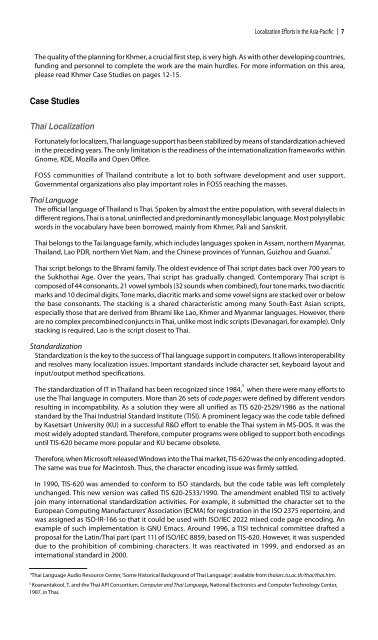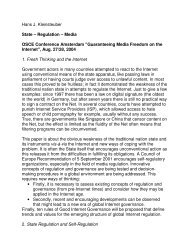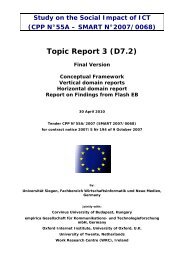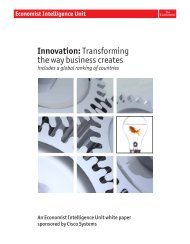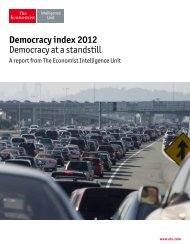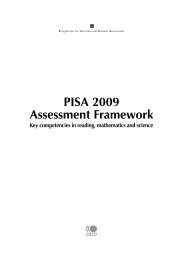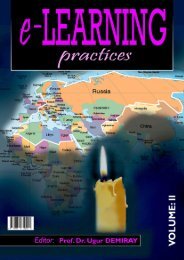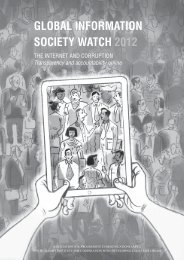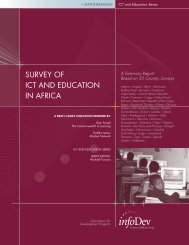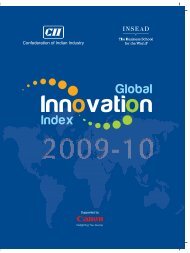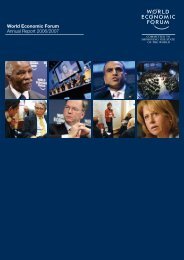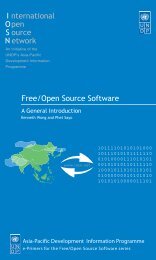Localization Efforts in the Asia-Pacific ❘ 7The quality of the planning for Khmer, a crucial first step, is very high. As with other developing countries,funding and personnel to complete the work are the main hurdles. For more information on this area,please read Khmer Case Studies on pages 12-15.Case StudiesThai LocalizationFortunately for localizers, Thai language support has been stabilized by means of standardization achievedin the preceding years. The only limitation is the readiness of the internationalization frameworks withinGnome, KDE, Mozilla and Open Office.FOSS communities of Thailand contribute a lot to both software development and user support.Governmental organizations also play important roles in FOSS reaching the masses.Thai LanguageThe official language of Thailand is Thai. Spoken by almost the entire population, with several dialects indifferent regions, Thai is a tonal, uninflected and predominantly monosyllabic language. Most polysyllabicwords in the vocabulary have been borrowed, mainly from Khmer, Pali and Sanskrit.Thai belongs to the Tai language family, which includes languages spoken in Assam, northern Myanmar,Thailand, Lao PDR, northern Viet Nam, and the Chinese provinces of Yunnan, Guizhou and Guanxi. 4Thai script belongs to the Bhrami family. The oldest evidence of Thai script dates back over 700 years tothe Sukhothai Age. Over the years, Thai script has gradually changed. Contemporary Thai script iscomposed of 44 consonants, 21 vowel symbols (32 sounds when combined), four tone marks, two diacriticmarks and 10 decimal digits. Tone marks, diacritic marks and some vowel signs are stacked over or belowthe base consonants. The stacking is a shared characteristic among many South-East Asian scripts,especially those that are derived from Bhrami like Lao, Khmer and Myanmar languages. However, thereare no complex precombined conjuncts in Thai, unlike most Indic scripts (Devanagari, for example). Onlystacking is required. Lao is the script closest to Thai.StandardizationStandardization is the key to the success of Thai language support in computers. It allows interoperabilityand resolves many localization issues. Important standards include character set, keyboard layout andinput/output method specifications.The standardization of IT in Thailand has been recognized since 1984, 5 when there were many efforts touse the Thai language in computers. More than 26 sets of code pages were defined by different vendorsresulting in incompatibility. As a solution they were all unified as TIS 620-2529/1986 as the nationalstandard by the Thai Industrial Standard Institute (TISI). A prominent legacy was the code table definedby Kasetsart University (KU) in a successful R&D effort to enable the Thai system in MS-DOS. It was themost widely adopted standard. Therefore, computer programs were obliged to support both encodingsuntil TIS-620 became more popular and KU became obsolete.Therefore, when Microsoft released Windows into the Thai market, TIS-620 was the only encoding adopted.The same was true for Macintosh. Thus, the character encoding issue was firmly settled.In 1990, TIS-620 was amended to conform to ISO standards, but the code table was left completelyunchanged. This new version was called TIS 620-2533/1990. The amendment enabled TISI to activelyjoin many international standardization activities. For example, it submitted the character set to theEuropean Computing Manufacturers’ Association (ECMA) for registration in the ISO 2375 repertoire, andwas assigned as ISO-IR-166 so that it could be used with ISO/IEC 2022 mixed code page encoding. Anexample of such implementation is GNU Emacs. Around 1996, a TISI technical committee drafted aproposal for the Latin/Thai part (part 11) of ISO/IEC 8859, based on TIS-620. However, it was suspendeddue to the prohibition of combining characters. It was reactivated in 1999, and endorsed as aninternational standard in 2000.4Thai Language Audio Resource Center, ‘Some Historical Background of Thai Language’; available from thaiarc.tu.ac.th/thai/thai.htm.5Koanantakool, T. and the Thai API Consortium, Computer and Thai Language, National Electronics and Computer Technology Center,1987, in Thai.
8 ❘ FREE/OPEN SOURCE SOFTWARE: LOCALIZATIONThe TIS-620 code table was pushed for inclusion in the Unicode table. Although the influence of the ISCIIencoding scheme (which forced all vowels, including the leading vowels, to always be encoded afterconsonants) had made the Unicode consortium force Thai to change its encoding scheme, TISI defendedthe TIS-620 practice, as Thai script did not need such complications. Although this made Thai (and Lao)different from other Indic scripts, it saved Thai (and possibly Lao) implementations from the big hindranceof lacking supporting technology for ISCII practice at that time, as well as from the burdens of migrationfrom the well-settled and widely-adopted practice. So all Thai language-processing codes for TIS-620and Unicode, apart from the necessary code conversion, are fully compatible.In addition to the character set, the Thai keyboard layout was standardized as TIS 820-2531 in 1988, andlater amended by adding keys for special symbols and published again as TIS 820-2538 in 1995. Anotherkeyboard variant designed after research on character frequencies, called Pattajoti, is also available. Butit is not as popular and is not a national standard.Thai input/output methods were also standardized through the efforts of the Thai API Consortium (TAPIC),which was formed by a group of vendors and academies and sponsored by the National Electronics andComputer Technology Center (NECTEC). The specification, called WTT 2.0 (from its Thai abbreviation‘Wor Tor Tor’, which stands for “Wing Took Tee” or “runs everywhere”), was published in 1991. Its contentswere composed of three parts, describing character set and encoding scheme, input/output methods,and printer identification numbers.Although not endorsed by TISI as a national standard, WTT 2.0 was adopted by virtually all the majorvendors who participated in the draft, including DEC, Sun, Microsoft, MacIntosh and IBM. WTT 2.0 hadenjoyed being the de facto national standard for seven years, until it was dubbed TIS 1566-2541 by TISI in1998.There are other activities 6with international standards bodies that promote understanding of Thailanguage requirements among vendors. For example, in 1998 the “tis-620” MIME character set wasregistered with the Internet Assigned Number Authority (IANA) for information interchange on theInternet. 7 Another example is an annex of ISO/IEC 14651, International String Ordering, describing howthe predefined sorting order for Unicode can be tailored to match the requirements of Thai string ordering.With these established standards, specifications for Thai implementations are clear and interoperabilityis guaranteed. The standards have played an important role in several developments in the Thai computerindustry, including FOSS localization.LocalizationThai localization of FOSS was started in 1993 by Thai students in Japan with the ThaiTeX project initiatedby Manop Wongsaisuwan as a first effort to use Thai in the versatile typesetting program. 8 Subsequently,the project was maintained by the Thai Linux Working Group (TLWG) 9 which was formed in 1999.Apart from Thai LaTeX, other surrounding UNIX environments have been modified by the same group ofpeople to support Thai. Their work may be summarized as follows:Manop Wongsaisuwan: ThaiTeX (ttex), X bit-map fonts.Thai Project (by Vuthichai Ampornaramveth): 10 cttex (C version of ttex), xiterm+thai (Thai X terminal),likit (Thai text editor for X).ZzzThai project (led by Poonlap Veerathanabutr): 11 thailatex-component, X bit-map fonts, Thaisupport in xfig, Thai-HOWTO and Thai RPMs.At the same time, other Thai support projects were developed by researchers of the NECTEC in Thailand,including:Virach Sornlertlamvanich: Thai support in Omega (Unicode-based TeX kernel), Thai in GNU. Emacs,machine translation, and many other NLP projects.6Karoonboonyanan, T. and Koanantakool T., Standardization Activities and Open Source Movements in Thailand, Country Report, MLIT-4,Myanmar; also available at www.nectec.or.th/it-standards/mlit99/mlit99-country.html.7Tantsetthi, T., ‘Campaign for Internet-Standard-Conforming Thai Usage’; available from software.thai.net/tis-620.8Wongsaisuwan, M., ‘Introduction to ThaiTeX’; available from thaigate.nii.ac.jp/files/thaitex.pdf.9Thai Linux Working Group, ‘Thai LaTeX’; available from inux.thai.net/plone/TLWG/thailatex.10Ampornaramveth, V., ‘NACSIS R&D Thai Project Page’; available from thaigate.nii.ac.jp.11eucthai, ‘ZzzThai Project’; available from www.fedu.uec.ac.jp/ZzzThai/.


